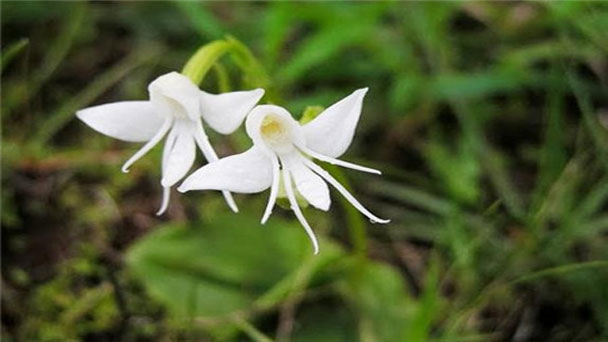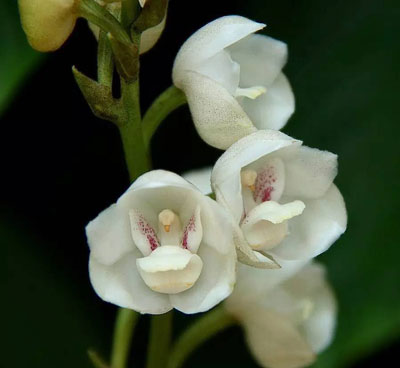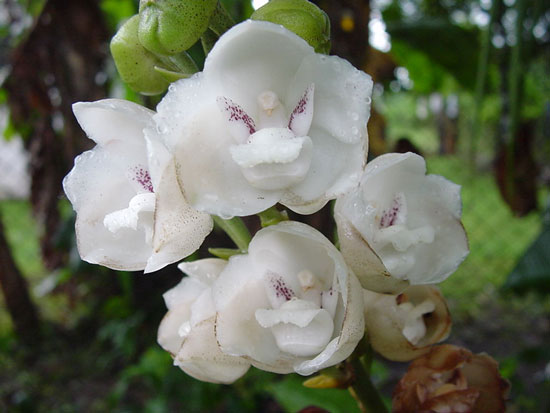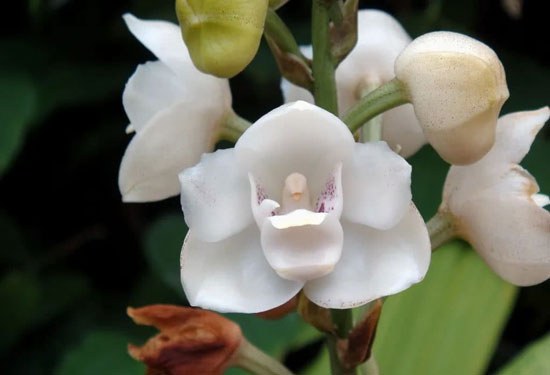Peristeria Elata: Grow & Care for Dove Orchid
Written by Iris
Nov 03 2021

Peristeria Elata (Dove Orchid) is a kind of orchid distributed from Central America to Ecuador and Venezuela. Its ethnic groups are distributed from Central America to Ecuador and Venezuela. They grow well in Panama's obvious dry and rainy climate. The flowering period is from November to April of the following year.


Leaf spot disease mainly damages leaves and causes diseased leaves to fall off. Most of them are caused by hot, unventilated and humid environments.
Black spot disease mostly damages the leaf surface. At first, it produces stains on the leaves, and then develops into nearly circular black-brown spots. In the later stage, when the lesions are severe, there are many black striped lesions and the leaves are sunken. It often occurs in areas with a lot of rain, and ventilation and light transmission conditions should be improved.
Bulb rot disease occurs at the base of the bulb and then invades the bulb. Even the flower stems are short and grow poorly. When the bulbs are not completely rotted, the basal leaves of the plants that grow from the diseased bulbs turn yellow or purple, and later gradually turn black rot from the base upwards, causing the entire bulb to rot and die. Control method: Avoid excessive water and fertilizer and dense plants. Once it occurs, remove the outer bulbs with black rot and destroy them. Try to avoid bruising the bulb to reduce the chance of infection by germs.
Aphids swarm on the young leaves and damage them, causing plant leaves to shrink, curl and fall off.
Greenhouse whitefly is a perennial hazard in the greenhouse. Adults and nymphs use their mouthparts to pierce the leaf flesh on the back of the leaves to suck the juice, causing the new tender leaves to curl, chlorosis and yellow, and even wither, which affects growth and flowering.
The damaged parts of scale insects are all in dark and unventilated places, causing plant leaves to wither and even fall off.
Starscream's damage is not easy to be found in the early stage, and the leaves turn dark green in severe cases, and even fall off.
How to Grow Peristeria ElataPeristeria Elata Propagation with Stem CuttingsPeristeria Elata Propagation with DivisionHow to Care for Peristeria ElataPeristeria Elata Light RequirementsPeristeria Elata WateringPeristeria Elata Temperature & Humidity CarePeristeria Elata FertilizerPeristeria Elata Pests & Diseases Care
How to Grow Peristeria Elata
Peristeria Elata Propagation with Stem Cuttings
In addition to the method of dividing plants, Peristeria elata (dove orchid) also can be used for cutting propagation of pedunculus. It can be in flower after the pedicel on the residual flowers even pedicel cut off, the pedicel from the base of the cut, and the pedicel branches and buds on the bracts carefully removed, revealing the buds. The pedicels cut off were buried in the ceramsite or sand bed with the temperature maintained at 25℃ ~ 30℃ and the humidity above 75%. After a few months, the internodes will grow small shoots with roots, which can be cut off and planted separately.Peristeria Elata Propagation with Division
More in the spring before the new bud germination, the growth of the dense cluster of false bulbs dugout, with 1 ball or 2 ~ 3 ball points planted in the new pot, the year can blossom. A strong old bulb that has been growing for many years will shed its leaves from the top of the stem and then sprout new buds. The tip of the leaf can also be cut at the top of the pseudobulb to stimulate its rapid initiation of multiple new buds. When the new buds grow a certain root system, they can be separated from the top and planted in the pot. After 2 to 3 years of cultivation, they can blossom.
How to Care for Peristeria Elata
Peristeria Elata Light Requirements
Peristeria elata (dove orchid) prefers a semi-overcast environment. Greenhouse potted flower production, appropriate half shade and half light environment, sunlight is too strong, will cause leaf burns or slow growth. But the shade is too large, the plant becomes weak and elongated and does not flower easily. Therefore, spring, summer, autumn three seasons can accept the morning and evening light, around noon with 50% ~ 60% of the shading net can be shaded.Peristeria Elata Watering
It is important to water this plant with clean water such as rain, distilled, or reverse osmosis. Except during the winter, the plant never wants dryness at the roots. The roots are hairy like a paphiopedilum, and require moisture at all times. The pseudobulbs should always be plump, round, and full. If they start shriveling, this is most likely a sign they haven't been watered enough. In the winter, try to mimic the dry season by leaving the plant somewhat drier in between waterings. At this time of year, it is OK to allow the pseudobulbs to shrivel slightly. Do this from the end of November through mid to late January. Overwatering can cause several problems such as root rot and infectious bacteria/fungus in the potting medium.Peristeria Elata Temperature & Humidity Care
To successfully breed Peristeria elata (dove orchid), it is necessary to ensure a good environment that it can adapt to. The required temperature is 2L ℃ ~ 33℃ in summer and 5℃ ~ 7℃ in winter. When the ambient temperature exceeds 35℃, it should be particularly noted that when the temperature is below 10℃ in winter, leaves begin to fall off gradually, that is, falling leaves enter the dormant period.50% or higher is ideal. The use of humidity trays or room humidifiers is beneficial.Peristeria Elata Fertilizer
Use GrowMore 20-10-20 Urea-free for municipal or well water. Use at the rate of ½ teaspoon per gallon. If using GrowMore with rain, distilled, or reverse osmosis water, add back in 5 - 10% municipal or well water to supply the necessary calcium and magnesium. Fertilize every other watering in the summer and every third watering in the winter. Other fertilizers offered are as follows: GrowMore 6-30-30 (Cymbidium and bloom boosting formula) and GrowMore 20-6-16 (Tropical plant food with calcium and magnesium additives).
Peristeria Elata Pests & Diseases Care
Peristeria Elata (Dove Orchid flower) has thin leaves, and rarely has leaf spot, anthracnose, black spot, bulb black rot, bacterial scab, aphids, whiteflies, scale insects and red spiders.Leaf spot disease mainly damages leaves and causes diseased leaves to fall off. Most of them are caused by hot, unventilated and humid environments.
Black spot disease mostly damages the leaf surface. At first, it produces stains on the leaves, and then develops into nearly circular black-brown spots. In the later stage, when the lesions are severe, there are many black striped lesions and the leaves are sunken. It often occurs in areas with a lot of rain, and ventilation and light transmission conditions should be improved.
Bulb rot disease occurs at the base of the bulb and then invades the bulb. Even the flower stems are short and grow poorly. When the bulbs are not completely rotted, the basal leaves of the plants that grow from the diseased bulbs turn yellow or purple, and later gradually turn black rot from the base upwards, causing the entire bulb to rot and die. Control method: Avoid excessive water and fertilizer and dense plants. Once it occurs, remove the outer bulbs with black rot and destroy them. Try to avoid bruising the bulb to reduce the chance of infection by germs.
Aphids swarm on the young leaves and damage them, causing plant leaves to shrink, curl and fall off.
Greenhouse whitefly is a perennial hazard in the greenhouse. Adults and nymphs use their mouthparts to pierce the leaf flesh on the back of the leaves to suck the juice, causing the new tender leaves to curl, chlorosis and yellow, and even wither, which affects growth and flowering.
The damaged parts of scale insects are all in dark and unventilated places, causing plant leaves to wither and even fall off.
Starscream's damage is not easy to be found in the early stage, and the leaves turn dark green in severe cases, and even fall off.

Latest Updated
- Benefits of Bugleweed - 7 Science-backed Health Benefits
- Bugleweed Dangers & Side Effects - Is It Poisonous?
- How to Plant Evergreen Trees - What You Should Know
- When to Plant Evergreens - Grow Guide for Evergreen Trees
- 12 Wonderful Evergreen Shrubs for Your Garden
- 12 Popular Evergreen Plants with Pictures for Beginners
- When And How To Prune A Lilac Bush Like a Pro
- How to Grow & Care for Lilac Vine (Hardenbergia Violacea)
- Japanese Lilac Tree (Syringa Reticulata) Care & Propagation Guide
- Shumard Oak Pros and Cons - What to Know
Popular Articles
- Winter maintenance of Antirrhinum Majus
- How to Grow Terminalia Mantaly Tree
- How to Grow and Care for Crossostephium Chinense
- How to grow Antirrhinum Majus in spring
- Peristeria Elata (Dove Orchid) Profile: Info & Care Guide
- Underwatered Snake Plant (Sansevieria Trifasciata) - Signs And How To Fix
- How to Care for Brazilian Jasmine Plant (Mandevilla Sanderi)
- How to Grow & Care for Graptopetalum Purple Delight in Summer
- Rosa Chinensis (China Rose): Plant Growing & Care Tips
- How to Care for Baby Sun Rose (Aptenia Cordifolia)